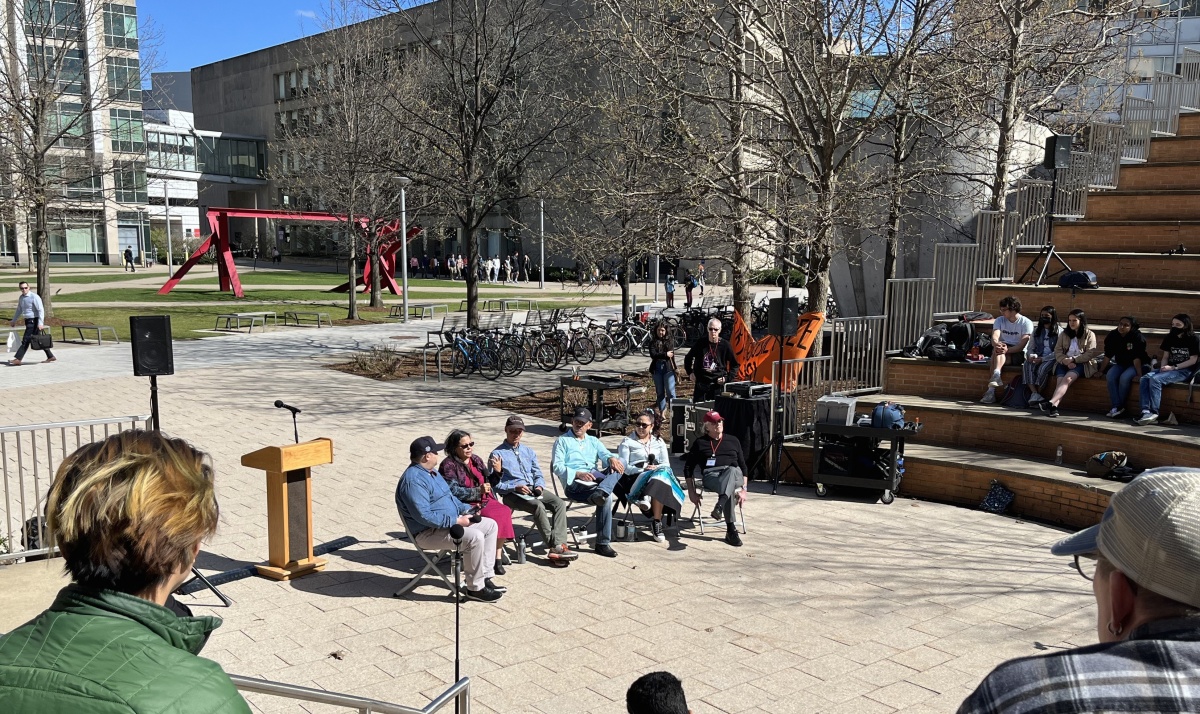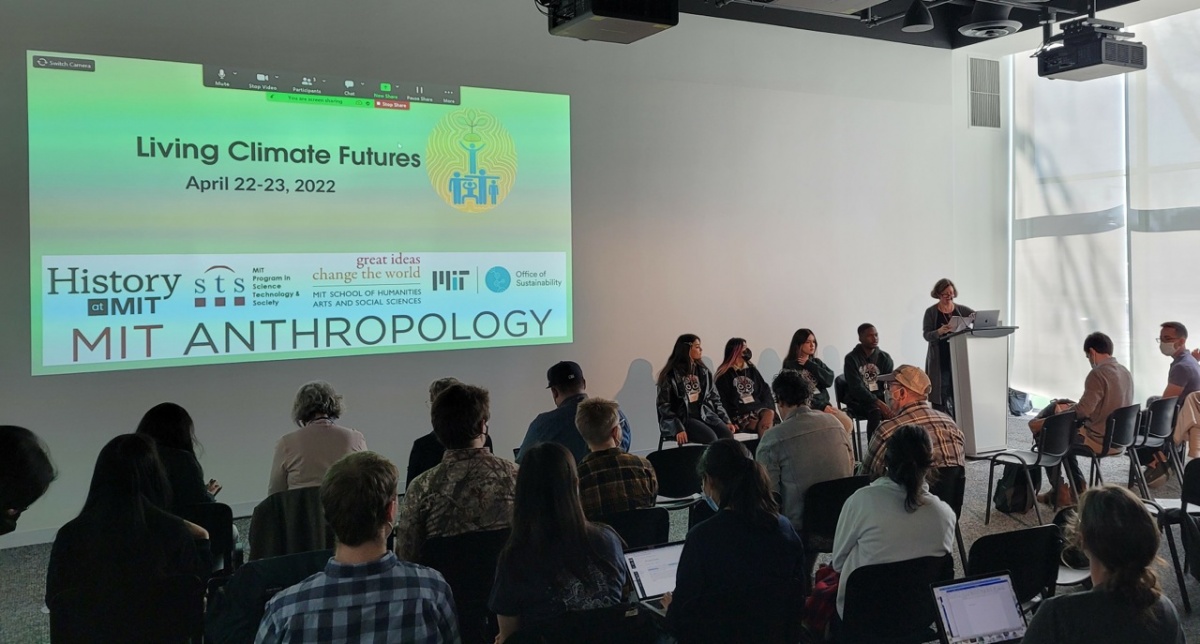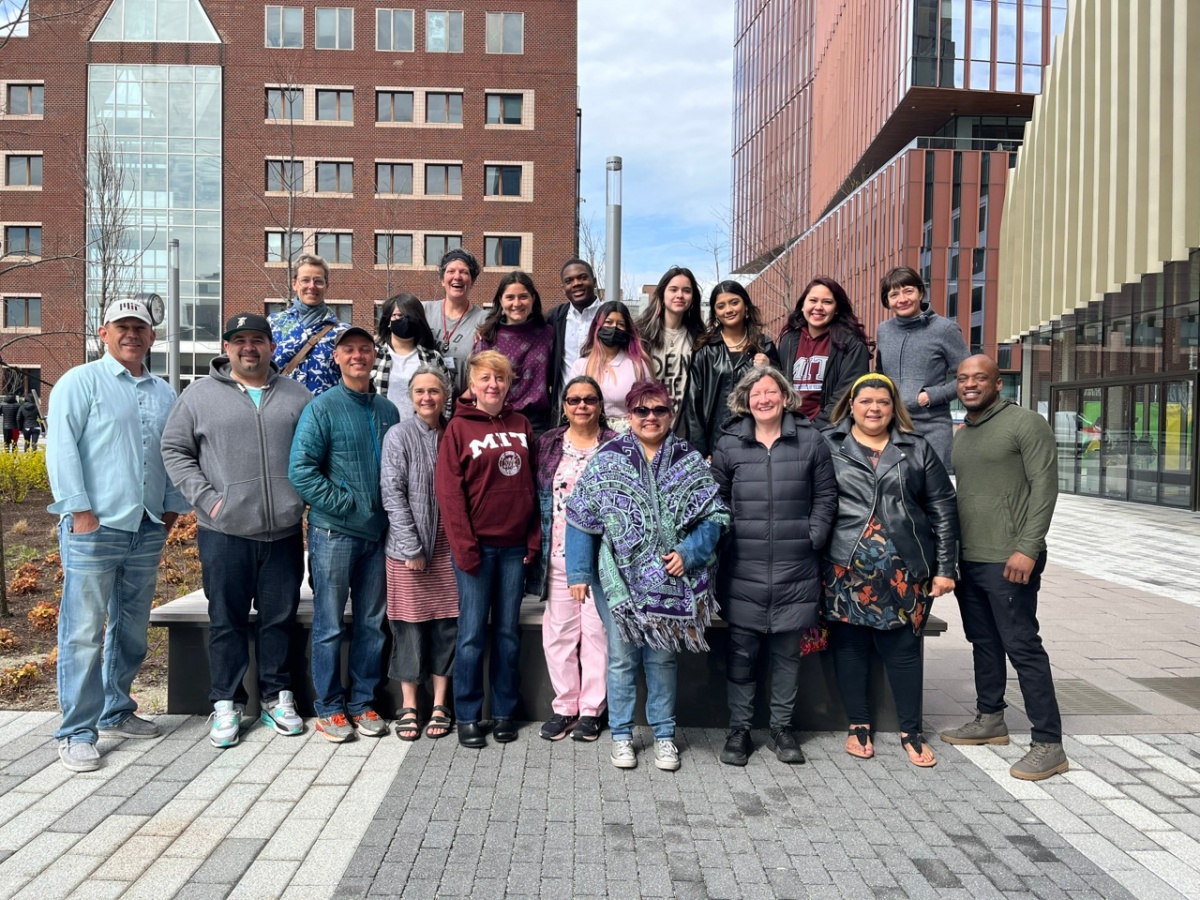Living Climate Futures Event Shows a Holistic Way Forward in Climate Fight
article by Stephanie M. McPherson
May 2, 2022

The sun shone bright and warm on the Dertouzos Amphitheater at the Stata Center this past Earth Day. A banner stating “Our Future is Fossil Free — Divest Now” waved from between two trees as a panel of Indigenous leaders and thinkers from across the country talked about their experiences with climate activism and their natural world philosophies — a worldview that sees humanity as one with the rest of the Earth.
“I was taught the natural world philosophies by those raised by precolonial individuals,” said Jay Julius W’tot Lhem of the Lummi Tribe of the Pacific Northwest and founder and President of Se’Si’Le, an organization dedicated to reintroducing Indigenous spiritual law into the mainstream conversation about climate. Since his great-grandmother was born in 1888 and his great-grandfather in 1892, he grew up “one hug away from pre-contact,” as he put it.
Natural world philosophies sit at the center of the Indigenous activism taking place across the country, and they were a highlight of the Indigenous Earth Day panel — one part of a two-day symposium called Living Climate Futures. The events were hosted by the Anthropology; History; and Science, Technology, and Society (STS) programs in MIT’s School of Humanities, Arts and Social Sciences (SHASS), in collaboration with the MIT Office of Sustainability and Project Indigenous MIT.
“The Living Climate Futures initiative began from the recognition that the people who are living most closely with climate and environmental struggles and injustices are especially equipped to lead the way toward other ways of living in the world,” said Briana Meier, ACLS Emerging Voices Postdoctoral Fellow in MIT Anthropology and an organizer of the event. “While much climate action is based in technology-driven policy, we recognize that solutions to climate change are often embedded within and produced in response to existing social systems of injustice and inequity.”
On-the-ground experts from around the country spoke in a series of panels and discussions over the two days, sharing their stories and inspiring attendees to think differently about how to address the environmental crisis.
“The speakers were all people who are not by choice but by necessity living on the front lines of climate and environmental crises,” says Heather Paxson, head of MIT Anthropology and an event organizer. “By sharing their own stories of struggle and success, they offered experiential knowledge that’s not often heard at MIT.”
The hope, according to faculty organizers, was that an event centering on-the-ground voices could create new connections among activists and open the eyes of more technically minded colleagues to the human element of climate solutions.
“We wanted to stage an event where the emphasis was on bringing different groups together — environmental justice as well as indigenous-oriented organizations — and see what emerged organically from these conversations and interactions in ways that would be meaningful to them moving forward,” says Christine Walley, professor of anthropology at MIT and an event organizer. “Living Climate Futures created a space for those interactions to happen.”

Indigenous Earth Day at MIT. Photo credit: Heather Paxson.
Over the years, many solutions developed to tackle the climate crisis have overlooked the needs of the communities they are designed to help. Streams in the Pacific Northwest, for example, have been dammed at areas of high rates of flow to generate hydroelectric power — promoted as a green alternative to fossil fuel. But these same locations have long been sacred spots for Indigenous swimming rituals, said Ryan Emanuel (Lumbee), associate professor of hydrology at Duke University and a panelist in the Indigenous Earth Day event. “They will say, ‘you’re giving us dead water!’” he said.
Emanuel expanded on this thought in a Saturday panel, saying that mitigating the environmental damage of interfering with sacred land does not make up for the loss of sacred connection.
To dig into such nuances, the organizers invited an intergenerational group of activists whose legal and policy successes ranged from starting successful urban farming co-ops to stopping a polluter from moving in across from a high school to being a part of halting the Atlantic Coast Pipeline.
Growing Food, Growing Community
The first panel of the Living Climate Futures event featured representatives from urban farms in Mansfield, Ohio and Chelsea, Massachusetts.
Urban farming offers access to healthier food options while providing benefits to the community. Farmers sell the food they grow, providing jobs in areas often affected by joblessness due to deindustrialization. In some cases, farming sites take over abandoned or polluted lands, greening and remediating the area in the process.
“Transforming urban spaces into farms provides not just healthy food, but a visible symbol of hope, a way for people to connect and grow food that reflects their cultures and homes, an economic development opportunity, and even a safe space for teens to hang out amongst the rows of lettuce,” said Susy Jones, Senior Sustainability Project Manager in the MIT Office of Sustainability and an event organizer. “We also heard about the challenges – like the cost of real estate in Massachusetts and the barriers to building a small business in a sea of large farms.”
The Richland Gro-Op in Mansfield has expanded beyond growing healthful food. They have reached out to the corrections facilities within the city of Mansfield to enlist the help of prisoners in the field, providing them in turn with internship credits and a strong sense of community purpose. The Gro-Op also partners with local schools to provide healthful ingredients for their cafeterias, and to give college credit for high school students studying food science.
“These urban farms might have one very narrow focus [in growing food], but their project grows outward from vegetables to jobs, to schools, to prisons, to create opportunities,” says Kate Brown, professor of Science, Technology, and Society at MIT and one of the event’s organizers.
The second panel of the day highlighted the determined and ultimately successful efforts of a group of students from George Washington High School in Southeast Chicago to derail a proposed scrap metal recycling plant right across the street from their school.
“We’re at school eight hours a day,” said Gregory Miller, a junior at the high school. “We refuse to live next door to a metals scrapyard.”
The plant proposed by General Iron was to replace something similar that had been shut down in the predominantly white Lincoln Park due to its many environmental violations. The Southeast Side of Chicago is more culturally diverse and has long suffered from industrial pollution and economic hardship. But, as the students knew intuitively, that did not give General Iron the right to further pollute their home.
Between a hunger strike and marches to the mayor’s and alderman’s houses, the students of George Washington High School achieved victory.
“It was hard, the campaign,” said Destiny Vasquez. “It was hard emotionally, even physically…But it was beautiful because the community came together. There is unity in our struggle.”

Professor Chris Walley introducing student speakers from Southeast Chicago’s George Washington High School. Photo credit: Alex Rewegan.
A Part of the Whole
Unity was also at the forefront of the discussion at the Indigenous Earth Day panel on that sunny afternoon in the Stata Amphitheater. This event began with a greeting in the Navajo language from Alvin Harvey, PhD candidate in Aeronautics and Astronautics (Aero/Astro) and representative of the MIT American Indian Science and Engineering Society and the MIT Native American Student Association. The greeting identified all who came to the event as relatives.
“Look at the relatives next to you, especially those trees,” he said, gesturing to the budding branches around the amphitheater. “They give you shelter, love…few other beings are willing to do that.”
According to Julius, such reverence for nature is part of the Indigenous way of life, common across tribal backgrounds — and something all of humanity once had in common. “Somewhere along the line we all had Indigenous philosophies,” he says. “We all need an invitation back to that to understand we’re all part of the whole.”
Understanding the oneness of all living things on Earth helps people of Indigenous nations feel the distress of the Earth when it is under attack. Donna Chavis, senior climate campaigner for Friends of the Earth and an elder of the Lumbee tribe, discussed the trauma of the forests near her home in the southeastern United States being clear-cut to provide wood chips to companies in Europe.
“They are devastating the lungs of the Earth in North Carolina at a rate faster than in the Amazon,” she said. “You can almost hear the pain of the forest.”
Jay Julius feels the same existential pain about the dwindling salmon population in the Pacific Northwest. The Lummi are traditionally a fishing people and spend eight months of the year on the water. “If the salmon disappear, my soul is gone,” he said. “As is my connection to my father who I lost.”
From Jay Julius’s successful cancelling of a coal port project on an ancestral burial ground to George Washington High’s triumph, the participants all spoke from direct experience.
“People are experiencing a climate crisis that is global in really different ways in different places,” says Paxson. “What came out of these two days is a real, palpable sense of the power of listening to individual experience. Not because it gives us the big picture, but because it gives us the small picture.”
Trinity Colón, one of the leaders of the group from George Washington High School, impressed on attendees that environmental justice is much more than an academic pursuit. “We’re not talking about climate change in the sense of statistics, infographics,” she said. “For us this is everyday life… [future engineers and others training at MIT] should definitely take that into perspective, that these are real people really being affected by these injustices.”
That call to action has already been felt by many at MIT.
“I've been hearing from grad students lately, in engineering, saying, ‘You know what? I like thinking about these problems, but I don't like where I'm being directed to use my intellectual capital, towards building more corporate wealth. I don't want to do that,’” says Brown. “As an institution, we could move towards working not for, not to correct, but working with communities.”
Abdulazeez Mohammed Salim ’22, an Aero/Astro major, says he was inspired by these conversations to get involved in urban farming initiatives in Baltimore, where he plans to move after graduation.
“We have a responsibility as part of the world around us, not as external observers, not as people removed and displaced from the world. We are not an other, and the world is not an experiment or a lab,” he said. “It's what we've got. It's who we are. It's all that we've been and all we will be. That stuck with me, it resonated very deeply.”
Salim also appreciated the reality check given by Bianca Bowman from GreenRoots Chelsea that success will not come quickly, and that sustained advocacy is critical.
“Real valuable change will not happen now, will not happen overnight, will not happen by just getting together a critical mass of people who are upset and who are concerned,” he said. “Because what we're dealing with are large, interconnected, messy systems that will try to fight back and survive regardless of how we force them to adapt. And so long term is really the only valuable way forward. That's the way we need to think of these struggles.”
But it’s a fight worth fighting, for the future health of our Earth as we know it. As Kurt Russo, executive director of Se’Si’Le, said to students, “You’re more powerful than you think you are, and they’re not as powerful as you think.”
Sitting on the sun-warmed stone benches, breathing the fresh spring air, the message from senior Civil and Environmental Engineering major Jade Ishii, president of the MIT American Indian Science and Engineering Society and Native Hawaiian, rang true. First speaking in Hawaiian, she shared a proverb that highlighted humanity’s responsibility to the land we life on and summed up one of the central themes of the Living Climate Futures event
“He aliʻi ka ʻāina, he kauwā ke kanaka: land is chief and man is its servant.”
For more information see our website: https://livingclimatefutures.org/

Living Climate Futures guest speakers and MIT organizers.